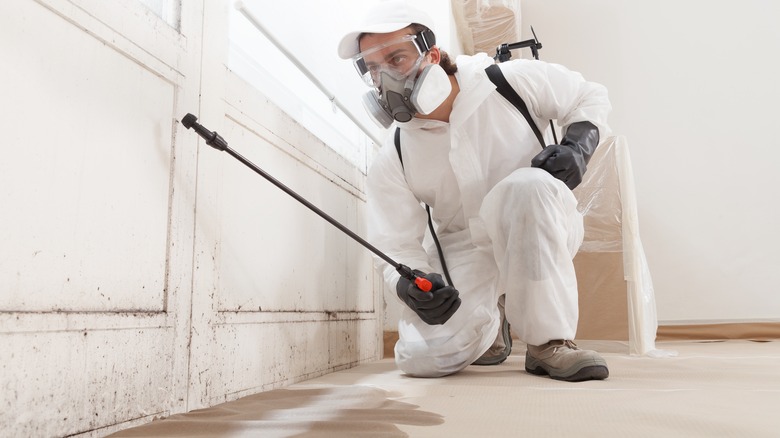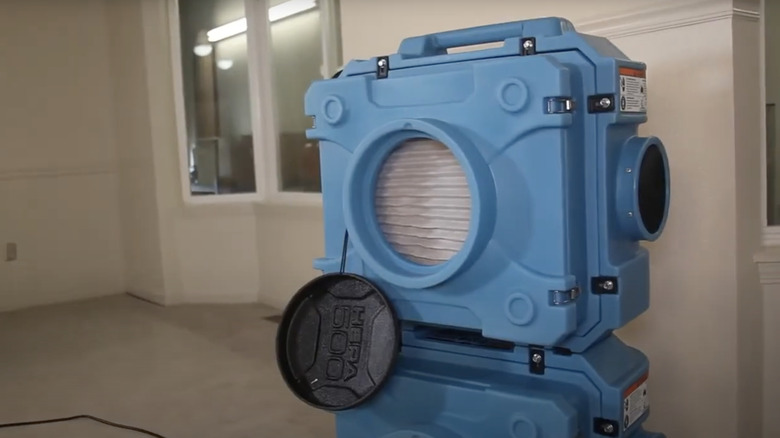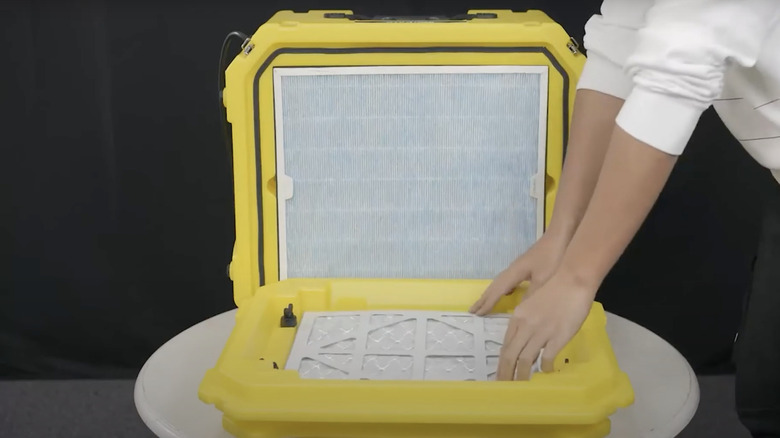How To Tackle Mold Spores In Your Home Just Like The Pros Would
We may receive a commission on purchases made from links.
If you've been using DIY ways to remove mold in and around your home, there's a chance that those pesky spores could still be in the air. Getting rid of every single mold spore likely isn't possible, but professionals use air scrubbers and purifiers with HEPA filters to ensure there's not an overabundance of them floating through your house. While tiny, invisible mold spores may not seem as threatening as the mold that was actually growing in your home, they can have negative implications for your health. When there's a lot of mold spores in a space, inhaling and touching them can cause allergy-like symptoms, though this can also happen with fewer spores, especially for those with asthma and allergies.
Because of the dangers of mold and its spores, it's crucial to address this issue right away; however, if you plan to tackle the problem like the professionals, it could be costly. You'll need to purchase a quality air scrubber to get rid of the mold spores, and these machines can range in price from about $250 to over $1000. This can vary based on the filtration system and the air volume range. For example, a popular mid-range choice for home use, the ALORAIR Air Scrubber, is about $400 on Amazon and can cover a space of 800 square feet. By using one of these machines in your home, you can start eliminating mold spores and ensure you're breathing clean air.
Why air scrubbers are helpful against mold spores
While air scrubbers and HEPA purifiers can filter the mold spores out of the air in your home, the first crucial step is killing and cleaning the household mold itself. To do this like the pros, consider using Sporicidin, a safe solution that is one of the strongest mold busters available. Additionally, you'll want to ensure that there is no excess moisture in your house, as lingering mold spores can grow from it. After the physical, visible mold has been taken care of, you're ready to set up your air scrubber, but there are a few things to keep in mind. You'll need to ensure that the air scrubber you're purchasing can handle the size of the area you're working with, is easy enough to lift and move to other rooms, and your particular scrubber has HEPA filters inside.
These devices are effective against mold because they suck in the air in your home. As the air passes through the several filters, particles that are so small they're invisible become trapped inside, including mold spores. This is why it's crucial to ensure there are HEPA filters inside your scrubber, as these are better for catching smaller particles. Air scrubbers are very effective because they can run continuously in your home to fight the spores. Using several scrubbers in one room can be even more helpful to prevent the spores from spreading, and may be the best method for handling serious mold issues.
How to use an air scrubber
Set up your scrubber in the most affected area of your home first, and adjust the flow rate to correspond with the filter you're using. The filters can sometimes catch more particles when the air is flowing slower, and if it's too fast the filters could have trouble keeping up. Check your machine's manual, as well as the size of the space, to get the right flow setting. Once you've allowed the scrubber to clean the air in one room, you can move it to other areas to help your entire house.
After running for a while, the filters will start to get full and will need to be changed. It's important to wear gloves and a mask while changing the filter to avoid breathing the spores, and you'll also want to take the entire air scrubber outside before removing the old filter out. This will keep the spores from falling from the filter and remaining in your home. By choosing the right air purifier to help get rid of mold spores and properly operating the air scrubber, you can make the air in your home safer again. With severe mold issues, it may be best to contact a professional for removal and remediation. This is generally the case if the physical mold covers an area more than 10 square feet.


